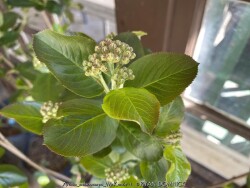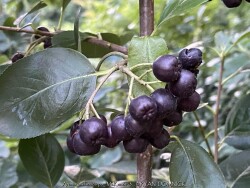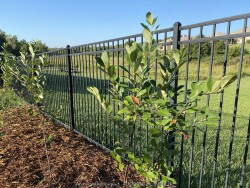



Plant Min Zone: 3a
Plant Max Zone: 8a
Sunlight: Full Sun, Part Sun
Water / Rainfall: Low, Average, High, Very High
Soil Quality: Average, Rich
Bloom Season: Spring
Flower Color: White
Berry / Fruit Color: Black
Spring Foliage Color: Green
Summer Foliage Color: Green
Fall Foliage Color: Orangish Red, Reddish Purple
Evergreen Foliage: No
Winter Interest: No
Scented Flowers: No
Drought Tolerance: Medium
Wet-Feet Tolerance: Medium, High
Humidity Tolerance: Medium, High
Wind Tolerance: Medium, High
Poor Soil Tolerance: Rocky Soils, Clay Soils
Height: 4' - 5'
Width: 4' - 5'
Growth Rate: Medium
Service Life: Long: 5-10 years
Maintenance Need: Low
Spreading Potential: Low
Yearly Trimming Tips: Trim Shrub to Desired Size After Bloom in Late Spring or Summer: Blooms on Old Wood.
Plant Grouping Size: Specimen Planting of 1-3, Small Grouping of 3-5, Medium Grouping of 5-10
Best Side of House: South Exposure, West Exposure, East Exposure, North Exposure
Extreme Planting Locations: Base of Retaining Wall Locations, Tolerates Periods of Standing Water
Ornamental Features: Long Lasting Fall Color, Multiple Seasons of Interest, Long Blooming Season, Easy to Eat Edibles
Special Landscape Uses: Naturalizing, Hedge Row
Possible Pest Problems: Rabbits, Deer, Foliage Disease
Plant Limitations: Environmental Stress / Decline
Shippable in 2026: YES
Black Chokeberry (Aronia melanocarpa), is an open, upright, spreading, somewhat rounded but leggy, suckering, deciduous shrub that typically grows 3-6' tall. It is native to low woods, swamps, bogs and moist thickets native from the Midwest to Canada. This 3-season shrub had appeal from spring to late fall starting with white flowers, then deep green summer foliage followed by brilliant red fall color and black berries. Plant in groups or mass plantings in small gardens or open woodland areas. Ability to withstand wet conditions makes it suitable for growing on the margins of ponds, streams, or rain gardens. Watch out for deer can devour young plants (protect with chicken wire if needed) but established plantings can generally outgrow deer browsing which offer free pruning to prevent legginess. The common name of chokeberry is in reference to the tart and bitter taste of the fruits which are edible but so astringent as to cause choking in most of those who try: no it's not poison!. Fruits are renowned for its antioxidant rich berries and high nutritional value and sometimes used to make tasty jams and jellies if enough sugar is added. Included in our "edibles" database but depends on how hungry you are! Aronia melanocarpa 'McKenzie' black chokeberry produces abundant fruit and improved fall color.